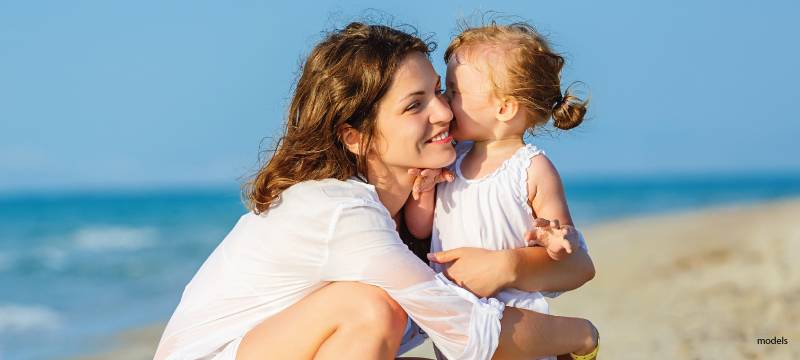Postpartum Hair Loss: What New Moms Should Know

After giving birth, many women will notice something unexpected, shedding strands of hair on the pillow, in the shower drain, or caught in a brush. While it can be alarming at first, postpartum hair loss is a common and temporary condition that affects nearly all new moms to some degree. In fact, in one study 90% of new mothers surveyed indicated some form of postpartum hair loss (Hirose et al., 2023).
Understanding postpartum hair loss (why it happens, what to expect, and how to care for your hair during this time) can make the experience less stressful and more manageable. In this post, we will explore the causes of postpartum hair loss, when it typically starts and stops, how to care for your hair during postpartum shedding, and when (if necessary) it is advisable to seek professional help.
What Causes Postpartum Hair Loss?
During pregnancy, rising estrogen levels cause more hair follicles to remain in the anagen (hair growth phase). This means less daily shedding and a fuller-looking head of hair. However, after delivery, estrogen levels drop rapidly. This sudden hormonal shift signals many hairs to enter the telogen, or resting, phase all at once—a condition called telogen effluvium.
This process can cause noticeable shedding, but it is important to remember that the hair follicles remain healthy. The shedding is temporary and will resolve on its own as hormone levels stabilize.
Common Symptoms of Postpartum Hair Loss
Postpartum hair loss often affects areas where the hair is naturally finer and more fragile, such as the temples, hairline, and crown. New moms may notice:
- Clumps of hair falling out during brushing or showering
- More hair left on pillows or clothing
- Thinning or widening around the front hairline
Though this can feel dramatic, especially if your hair seemed thicker during pregnancy, the shedding is usually temporary and followed by regrowth.
When Does Postpartum Hair Loss Start—and When Will It Stop?
Most women notice increased shedding about 2 to 4 months after giving birth, with the heaviest shedding often peaking around 3 to 5 months postpartum. In most cases, postpartum hair loss slows down and begins to resolve by the 6- to 12-month mark.
As hormones gradually return to their pre-pregnancy state, the hair growth cycle normalizes and shedding decreases.
Hair Regrowth: What To Expect
For most women, postpartum hair loss ceases on its own without intervention. Hair regrowth often starts with the appearance of short, fine strands, sometimes referred to as “baby hairs,” along the hairline or temples. These hairs may be softer, curlier, or have a slightly different texture than your original hair. Over time, they will blend in and contribute to a fuller, more even look.
It can take several months for this new hair to grow long enough to match the rest of your hair in volume and appearance.
Can Postpartum Hair Loss Be Prevented—or At Least Minimized?
Unfortunately, there is no way to completely prevent postpartum hair loss—it’s a natural part of the body’s return to hormonal balance. However, you can support your body and minimize excessive shedding by maintaining overall health and wellness:
- Eat a nutrient-rich diet with plenty of protein, iron, zinc, biotin, and vitamins D and B12.
- Manage stress through rest, relaxation, and support from loved ones.
- Continue taking prenatal vitamins if recommended by your doctor.
- Avoid harsh hair treatments like bleaching, perming, or tight hairstyles that put extra strain on your hair.
How to Manage Shedding While It Lasts
During this transitional phase, small changes in your hair care routine can make a big difference:
- Be gentle: Avoid excessive brushing and hairstyles that pull at the scalp.
- Detangle carefully: Use a wide-toothed comb when hair is wet to reduce breakage.
- Support hair from within: Stick to a balanced diet and continue prenatal vitamins.
- Wash wisely: Shampoo only as needed, and always follow with a moisturizing conditioner.
- Choose soft accessories: Use scrunchies or loose clips instead of tight elastics.
- Limit heat styling: Air-dry when possible and minimize use of curling or flat irons.
- Skip harsh chemicals: Delay any coloring or chemical treatments until shedding subsides.
- Consult a physician: If shedding is severe or accompanied by fatigue or mood changes, it may signal an underlying condition like postpartum thyroiditis.
What Hair Products Should Postpartum Women Use?
Look for products that are gentle, strengthening, and free from harsh ingredients:
- Sulfate-free shampoos and conditioners to avoid stripping natural oils
- Volumizing products that add body without weighing hair down
- Leave-in treatments with keratin, peptides, or biotin to support hair strength
- Avoid heavy oils or thick products that may build up and cause flatness
- Optional: For some women, topical minoxidil may be appropriate. We encourage you to discuss this option with a dermatologist
Tips for Styling Thinning Hair
Even with shedding, styling can help create the appearance of fullness and keep you feeling confident. Here are some ways to style your hair during postpartum hair loss:
- Try layered cuts or blunt ends to enhance volume
- Use root-lifting sprays or volumizing powders for added body
- Air-dry with texturizing sprays for a natural, tousled look
- Incorporate headbands, scarves, or hats for both fashion and function
- Dry shampoo can extend time between washes and provide lift
Emotional Impact and Self-Confidence
Hair changes after pregnancy can affect more than just appearance, they can also take a toll emotionally. It is completely normal to feel frustrated, anxious, or self-conscious during this phase. Remind yourself that:
- You are not alone, postpartum hair loss is common and some degree happens to nearly all new moms
- Remember, shedding is a temporary phase
- Your hair will recover in time
If postpartum hair loss is affecting your confidence or emotional well-being, consider speaking to a provider or mental health professional for support.
Will the Hair Loss Resolve on Its Own?
Yes—postpartum hair loss almost always resolves naturally. As hormone levels normalize, hair begins to regrow and shedding subsides. Most women experience full regrowth within 6 to 12 months. The earliest signs may look like short baby hairs near the temples or along the hairline.
What to Do If Hair Loss Continues
Patients should consider contacting a healthcare provider if significant shedding persists beyond one year postpartum. In those instances, continued hair loss could be a symptom of a deeper issue such as:
- Thyroid dysfunction
- Iron deficiency
- Androgenetic alopecia (a genetic form of hair thinning)
- Autoimmune conditions
A board certified dermatologist can identify the underlying cause and recommend personalized treatment to support hair recovery.
Sources
Hirose, A., Terauchi, M., Odai, T., Fudono, A., Tsurane, K., Sekiguchi, M., Iwata, M., Anzai, T., Takahashi, K., & Miyasaka, N. (2023). Investigation of exacerbating factors for postpartum hair loss: A questionnaire-based cross-sectional study. International Journal of Women’s Dermatology. https://www.ncbi.nlm.nih.gov/pmc/articles/PMC10846762/
Disclaimer: The contents of the Westlake Dermatology website, including text, graphics, and images, are for informational purposes only and are not intended to substitute for direct medical advice from your physician or other qualified professional.
